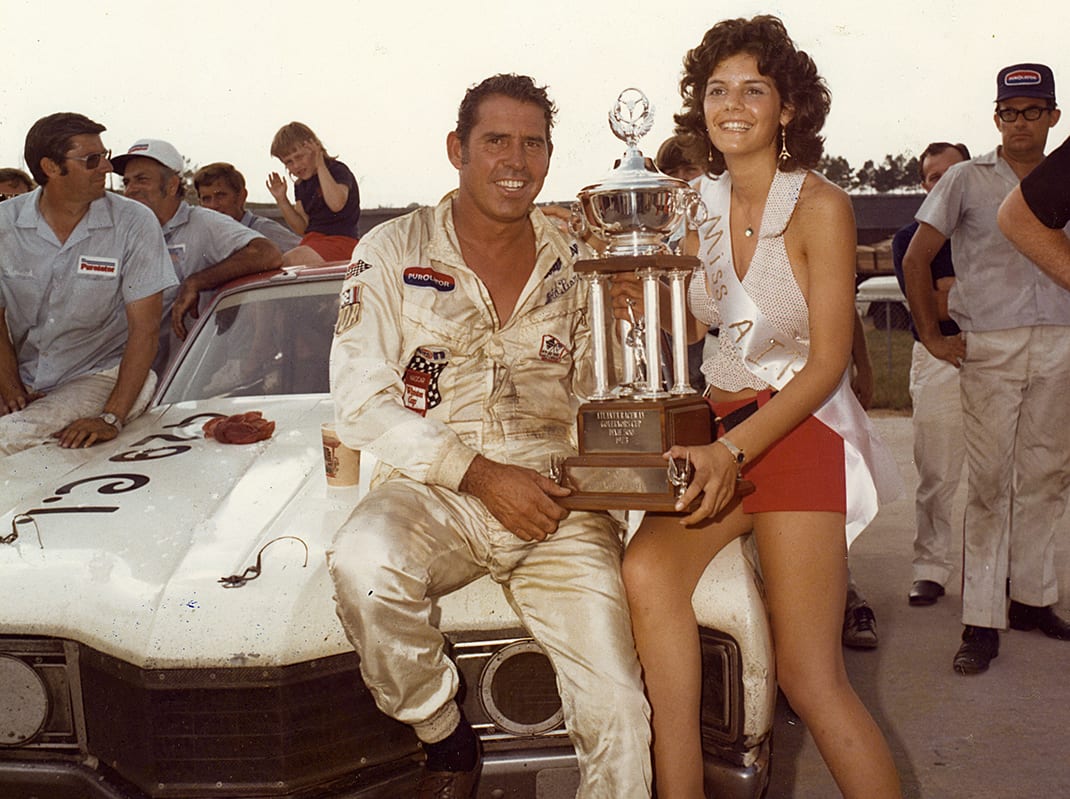Competitors knew they were in trouble when they saw Pearson in their rearview mirrors.
“In 1972, I bought a car from Holman Moody and was going to set the world on fire,” said three-time Cup Series champion Darrell Waltrip. “That was my first season and I’d be out there racing as hard as I could go and here comes Pearson flying by me smoking a cigarette like he was on a Sunday drive. That’s when I knew I had a lot to learn about driving in big-time stock car racing.”
Waltrip wasn’t exaggerating. Pearson did have a cigarette lighter installed in his race car.
“I used to smoke under caution, and I’d look over at the other guys and just grin,” Pearson said. “I think it worked on their heads some and psyched them out a little bit. That was part of the game. You did everything you could to work on the heads of the other drivers.”
Wood Brothers Racing has always built top-notch, winning cars. After all, A.J. Foyt drove the No. 21 to victory in the 1972 Daytona 500 and the Miller High Life 500 at Ontario (Calif.) Motor Speedway. Pearson had driven for Holman Moody since 1968 and won three championships and 30 races for the powerhouse Ford operation.
When it closed in early 1972, Pearson needed a ride, joining team owner Ray Nichels for seven races. When Foyt turned his attention to the Indy car schedule, Glen Wood called on Pearson and the pairing resulted in six superspeedway wins that year.
At the start of the 1973 season, no one could have imagined the success that was coming. The Cyclone’s chassis was built by Holman Moody in 1970 and originally raced by Parnelli Jones at California’s Riverside Int’l Raceway.

“Back then, we were sort of on our own,” Glen Wood said. “The factories weren’t paying for anything. In fact, they had quit at the end of 1970, so we had to make do with what parts and supplies they had given us over the years.
“Sheet metal was no problem to find but there were no more of the hemi engines. We had several, enough to last us a good while. We probably had 15 or 20 I guess.”
Another reason for the awesome 1973 season was that Pearson never wrinkled a fender on the car, always bringing it home in pristine condition. The only cosmetic damage, if you will, came from some rather exciting victory lane celebrations, leaving scratches or scrapes here and there.
There was, however, a second No. 21 Cyclone that was raced a couple of times during the 1973 season that was caught up in a multi-car crash at Charlotte Motor Speedway in October. All 11 wins came in the car the Woods never named but now affectionately call “The ’71 Mercury.”
From March 18 through May 6, Pearson won five consecutive races and between June 3 and July 22, he won another four in a row. Two more came later in the season.
Because cars were only eligible for NASCAR competition for three years, the famed Cyclone was retired from competition on Jan. 20, 1974, after a third-place finish at Riverside.
For many years, Pearson’s greatest ride sat on display at the Darlington (S.C.) Raceway Stock Car Museum & NMPA Hall of Fame. Pearson drove the car a final time on April 17, 2008, in an exhibition run to unveil the track’s new pavement. The car is now at the Wood Brothers Museum in Stuart, Va.
Eddie Wood, 21 years old in 1973, remembers how calm Pearson was inside the race car.
“You never really knew what he had left in the car,” Eddie Wood said. “He would never show his hand until it was time, sort of like playing poker. He would never run a lap in practice as fast as what he qualified. He knew what he had but no one else did, including us. As time moved on, we started counting on that. David was a quiet guy, but he talked with us when we were around the garage. When it came to the car, he didn’t say very much.”
Pearson didn’t have to. He let his right foot and masterful skill do all of his talking.
